 Final Fantasy XV
Final Fantasy XV
Getting the opportunity to have an hour of hands-on time with the Final Fantasy XV Episode Duscae demo was my most anticipated activity for PAX East. My expectations were tempered going in as this would be the first action-based combat Final Fantasy main-entry, and it would be safe to say that there is some doubt on how well the series would make the transition, but for the most part, my fears were unfounded. My sentiments echo those of Michael Apps in his Impression, as we sat together and discussed the experience during our time with the demo.
The game appears built to a grand scale with beautiful landscapes that help to make the world feel alive and immersive. The player can see movement and activity far in the distance, and can travel to almost anything seen, so these objects are not merely background scenery. The player takes control of Noctis, who is referenced as a prince or some sort of nobility by his three companions, who are non-playable party members. The open world nature of the game will be familiar to fans of the Xenoblade Chronicles, or most MMORPGs. There are quest points on the map that can be selected, and will show up as waypoints when traversing the land, but the menu for this system is somewhat clunky and unintuitive. It would be nice for a smoother way to view and mark quest points, and the addition of a mini-map would go a long way towards addressing this.
Combat in Final Fantasy XV is hectic, as the party will often get ambushed by several enemy creatures or soldiers, and can be disorienting at times. Often, the party would go into a combat mode signaling a nearby or attacking enemy, but I would struggle to actually locate this threat initially to get my group in position for battle. Once engaged, targeting enemies and keeping the camera in control can be challenging at times. Many of Noctis' attacks are directional, and the player needs to target the enemy and line them up for an attack. Fast moving enemies can make executing these attacks difficult, but I feel that with some time and practice, one would get this mechanic down. That being said, combat is rewarding, and made especially satisfying when Noctis successfully pulls off a Jump special attack, a Warp Strike, or an area attack called Tempest. One has to be careful not to mindlessly spam these attacks, as they consume MP, and running out of MP causes Noctis to go into Stasis mode which all but incapacitates him briefly.
The effectiveness of your party members AI was hard to gauge, as I often did not notice them or what they were doing, besides just being aware of their presence. In the demo, the player has no ability to control or direct the AI party members. The ability to issue some party member commands, or even something similar to Final Fantasy XII gambits would be most welcome, but it is unknown at this time if this feature will make it in the final release. As it stands, combat is almost purely reactive and straight-forward with little opportunity to employ any real semblance of strategy. This could lead to combat being initially fun, but eventually shallow and dull towards the latter stages of the game.
The graphics are impressive and detailed, especially so during the massive behemoth sequences the party tracks throughout the demo. There were some perfomance issues however, with noticeable framerate dips, and rough edges. These blemishes stand out more perhaps due to how nice the game looks otherwise, but there is some fear the developers may have bitten off more than they can chew. The music is on par with what a Final Fantasy fan has come to expect from the series, and the small sampling from the demo did not disappoint. The demo for Final Fantasy XV shows a lot of promise but leaves a list of items that could use some polishing before it is finally released. If nothing else, this entry will be a unique one for the series, but here is hoping for it be remembered for the right reasons.
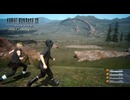 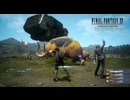 
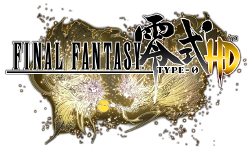 Final Fantasy Type-0 HD
Final Fantasy Type-0 HD
I spent a bit of time with the demo of Final Fantasy Type-0 HD on the showroom floor, though because the full game has been released, with many reviews posted, my impressions here will be brief. Unlike my pleasant surprise with the demo of Final Fantasy XV, I was somewhat disappointed with the Type-0 HD demo. The action-based combat was mostly entertaining, if not somewhat spammy in the way it controlled, and the limited nature of the demo fails to allow for much customization or depth. However, it was really held back by the camera and camera control. The camera continued to aggravate throughout my experience with the demo, and it really marred the entire experience. This could perhaps be alleviated somewhat with further play, and growing accustomed to the camera, but it is bound to be an early turn-off for many.
The game also somehow manages to look great and rough at the same time. Some lighting effects are impressive, but it is obvious that the game is a PSP port with an HD treatment. The music was definitely a high point of the experience and has the potential to be on the level of some of the other better Final Fantasy soundtracks. With the exception of the music, the game does not really feel like a Final Fantasy game, but more like a generic action-RPG with Final Fantasy inserted into the title.
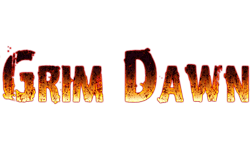 Grim Dawn
Grim Dawn
The hack and slash Diablo-clone Grim Dawn was one of my pleasant surprises of the show. As a fan of the genre, I was immediately in my comfort zone during my hands-on time with the demo. Grim Dawn was succesfully funded on Kickstarter in 2012 and is currently in Early Access on Steam, with developer Crate Entertainment estimating it at about 70% complete. Grim Dawn is set in a post-apocalyptic world created by two warring powers. One sees humanity as a resource, while the other wants to deprive their enemy of that resource. The game has five playable classes and all five were available at the demo at different levels of strength and progression. I played as both the melee Soldier class and the ranged magic class the Arcanist.
The visuals of the game are best described by the cliched terms "dark" and "gritty." The characters and environments show the depressing ravages of war, while the enemies are gruesome and oppressive. Some may be turned off by this style, but it suits the game well and gives the game a distinct feel that accurately captures the tone the developer intended. The spell and ability effects are bright and eye-catching and the deaths are brutal with lots of blood and dismemberment that compliment the frantic action of combat well. There are intermittent weather effects that pop up at times that didn't seem to have any direct impact on the game, but were a nice ambient touch that wasn't too intrusive.
Combat in Grim Dawn is familiar to any veteran of the genre. The game allows customizable hot-bars for skills and attacks and the player moves around in the isometric view by incessant mouse-clicks. The game's difficulty isn't very forgiving as there were several character deaths, but it didn't seem overly punishing to the point it wasn't enjoyable. When you die, your character loses some experience, though some can be redeemed back if you can locate and reach your corpse before dying again. The two classes I played felt unique and the experience of playing each was quite different, and these classes can be further customized by dual-classing. Classes have skill trees, and players can take a broad approach, getting more of a mix of skills and abilities, or they can take a more specialized approach by going deep into specific branches of the tree. The ability to dual-class allows characters to dip into the skill tree of another class to compliment their own, and ramps up the customization of the game to create unique characters and play experiences.
 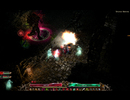 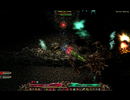
 Xenoblade Chronicles 3D
Xenoblade Chronicles 3D
My time with Xenoblade Chronicles 3D was short, but the gameplay is of course what one would come to expect from the game with it being a port of the Wii release. While it is impressive that the game could be made playable on the 3DS, it seems as if the Wii release will still be the definitive version. The textures, and characters especially, are noticeably jagged. The game will also only be playable on the New Nintendo 3DS, which will be a barrier to fans who have yet to upgrade to the latest system iteration. However, for many, the slight graphical degradation will be well worth it to get to play this grand RPG on the go.
Legends of Eisenwald
Legends of Eisenwald is also a Steam Early Access game that is the result of a successful Kickstarter campaign, and is beng developed by Aterdux Entertainment out of Belarus. I played the latest build of the game alongside Alexander Dergay of Aterdux Entertainment as he provided me valuable tips and acted as a live tutorial and guide during my session. The Legends of Eisenwald could accurately be compared to Heroes of Might & Magic and the King's Bounty games. You control a hero, which can be a knight, baroness, or mystic, and a small party of soldiers across a sprawling world map with movement similar to Heroes of Might & Magic. When engaged in combat, you fight on a hex-based grid resembling the area in which the fight was initiated. The Legends of Eisenwald takes a low-magic medieval approach to the setting relying on the likes of knights, pikemen, and archers to fill the ranks of the squad.
Despite combat being grid-based and tactical, movement during the battles is surprisingly limited. More important than movement is the initial placement and formation of the troops. Archers and support classes such as bishops and witches are in the back and middle rows, while knights and pikemen are up front. There are also rules of engagement in regards to who you can attack. Frontline melee fighters have to fight their adjacent enemies, as they aren't free to run around in the back and hit an archer unless the front row fighter in front of them has been dispatched first. The strategy is therefore much more focused on match ups, turn order, and special abilities and skills. A mounted character suffers penalties going up against a frontline of pikemen, but can beat up on other types of units, so it would be smart for the mounted unit to attack the knight with the sword instead. Conversely, a witch can pull down units from their mounts, making them a more vulnerable target, which your front-line melee fighters can then target to dispatch more easily, and then opens up the back rows to melee attack.
The game offers a fairly deep progression system for classes. Experience is gained by individual performance in battle, and there are many different advanced classes and paths to develop into. For example, an archer can choose to develop into a longbowman or a crossbowman and then advance down the chosen path three more times. Non-hero characters are generic and can be recruited at certain locations on the global map, or the hero can purchase mercenaries who are generally more powerful initially, but have to constantly be paid.
My time with the game mostly focused on the combat and character classes, but I did spend some time traversing the global map and initiating quests. Travelling to various buildings, be it a tavern or a massive castle, triggers the majority of the game's dialogue and interaction. In these buildings, you can recruit characters, buy weaponry, armor, and other supplies, acquire or turn in quests, and initiate an attack on a defended keep. Capturing buildings will supply your side with whatever resource or monetary income it provides. However, with only one hero character, there doesn't seem to be an easy way to defend your buildings from enemies. You can leave units in castles to defend them, but ordinary buildings lack any sort of defense.
The game is still not complete and is rough around the edges in some regards, with the UI and cursor sticking out the most. Selecting an attack or skill, and hovering or clicking on an enemy to select a target, wasn't always easy to determine if the command registered properly. An occasional graphical hiccup or stutter occured, but otherwise the build ran very smoothly. The game may also not be very forgiving to a new player. The learning curve would have been much steeper, and I would've stumbled my way through combat had Alexander not been advising me as I played. However, he did inform me that since I started in the middle of a pre-played and saved scenario it was more difficult than a fresh campaign, as players will gradually learn the game mechanics, as opposed to getting them all thrust upon them at once. Overall, I enjoyed Legends of Eisenwald during the play session as the combat has the potential to be addicting and the character progression rewarding, and fans of in-depth tactical combat should take notice.
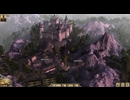 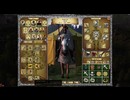 
�
 Boot Hill Heroes Episode 2
Boot Hill Heroes Episode 2
I sat down with David Welch of Experimental Gamer Studioes for an opportunity to play an early build of Boot Hill Heroes 2. The first episode of the spaghetti western-themed JRPG-inspired game released last year to a positive critical reception, and the sequel plans to pick up right where the first game left off. The demo played and felt just as the first did, and David informed me the sequel has been optimized with updates, and more skills, abilities, and enemies are being added for the upcoming sequel. No new plot information was divulged to me, but the demo was set in a small town area with a railroad running through the center of town. I controlled the party movement and three characters, while Dave took control of the fourth as the party ran around town fighting dogs, rats, and bandits in the process of attempting to complete a few quests.
Combat is tough as one of those stray dogs in town would easily one-shot a character on a few occasions. We had to limp around town with a few characters incapacitated and surving by the skin of our boots while waiting for them to recover. This did add a level of suspense and tension that is often missed in some RPGs, and I found it all the more rewarding because of it. As comfort with the combat mechanics and skills increased, we were able to chain some skills together that played off one another. As an example, one character would stun the enemy, while another set him on fire, which then allowed a third character to do an attack that scales damage based on the number of status ailments an enemy has. The threat of failure, coupled with co-op combat gameplay that can be frantic at times, offers a rare unique experience in these traditionally single-player games. I thoroughly enjoyed my time with the demo and fans of the first game should be looking forward to diving into the sequel.
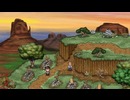
Breach & Clear: Deadline
Breach & Clear: Deadline came as a surprise when I stumbled across it in the Devolver Digital Lounge at PAX South. This follow-up to the original Breach & Clear could be more accurately referred to as a spin-off rather than a sequel, as the gameplay and setting take a dramatic shift from the original. Breach & Clear: Deadline is still in Early Access on Steam, and the build I played showed signs of that as I encountered a few bugs and freezes, but the developer Mighty Rabbit Studios assured me these would all be worked out by the time of final release. The game is a mash-up of real-time strategy, turn-based tactical combat, and even a shade of tower defense, as your crew blasts zombies.
The player takes control of a squad of four soldiers who are stranded in the midst of a zombie apocalypse. The game is open world with no real narrative besides some quests and the team's efforts at survival. You control the characters in a top-down isometric view and can toggle between movement in real-time or tactical turn-based modes. I found it most effective to move my team in real-time while exploring, and switch to tactical mode for combat, though one could conceivably do it all in either mode. Real-time combat against multiple enemies may become too overwhelming for many, myself included, but the developers said some players were having success with combat in the mode. Positioning characters in strategic locations behind cover or obstacles is critical to survival as it creates a killing field when the zombies attempt to approach the squad. Players assign commands for position and targets, with the real-time mode featuring a pause option, and then watch as the team unload on the enemies. In this regard, combat somewhat felt like a tower-defense game, but a bit more dynamic as the player will reposition the squad on the fly, as the battle conditions and enemy movement alter the situation. Breach & Clear: Deadline may fly under the radar for many RPGamers, but the demo showed potential and is a project worth following.
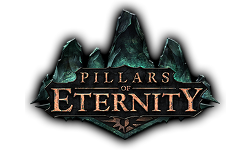 Pillars of Eternity
Pillars of Eternity
This is the only game in the article that I did not have any actual hands-on time with at the show, but instead it was shown during two panels where several members of developer Obsidian presented live gameplay and followed up with a Q&A session. Pillars of Eternity is one of the most anticipated games of 2015 for RPGamer.com staff, and its release date is right around the corner. This project was a very successful Kickstarter campaign and promises to be a throwback to classic Infinity Engine PC RPGs such as Baldur's Gate, Icewind Dale, and Planescape: Torment. Pillars of Eternity plans to capture the magic of those games, while also modernizing some of the aspects that have not aged as well for modern gamers.
Combat for Pillars of Eternity is the real-time with pause format that will be familiar to any who have played the aforementioned Infinity Engine games. One of the complaints of combat in these games was that it was a bit basic, as most non-spellcasters only had a standard attack. Pillars looks to remedy this by offering up a myriad of skills and abilities for characters of all classes to unleash upon their enemies. Combat should be more engaging and deep, and will stand up to the generally long length of these epic adventures. Other ease-of-use features shown off were fast and slow modes. Fast modes will make the process of back-tracking and traveling through large areas much less tedious, while slow mode will slow down combat enough to allow the player to issue more commands on the fly, and lessen the need to pause the action for minor tweaks in the midst of battle.
Another complaint against the old games was the lack of usefulness of many class skills. The panels showed off many instances of uses for these skills in dialogue situations and in a feature called scripted interactions. In these scripted interactions, a story-book like sequence pops up on the screen giving the player several options on how they want to approach a given challenge. The level of success of the sequence, or even health of the party, is based on the decisions made in these sequences combined with the skills of the party members. Both demos showed different sequences involving a cave or sewage entryway under water, and a character with a low athletic skill could possibly get fatigued or drown during this sequence, while an aptly skilled character would be able to get through unscathed, or discover a hidden item. This feature looks to add that missing layer to the gameplay, and make the non-combat sequences more robust, thus enhancing the overall RPG experience.
The panel gameplay also showed off four of the eight characters that can be recruited with some examples of inner-party banter and dialogue. Those in attendance also had a chance to get some first looks at the Stronghold mechanics in the game. The Stronghold is the party's base of operations that can be upgraded, visited by NPCs, attacked, and will house the extra eight recruitable and eight player-created characters that are not in the active party. The Stronghold has a prestige and security rating which can be raised or lowered based on in game events, current visitors, and the buildings in the Stronghold. Raising prestige will generate more and better events, but will also encourage your Stronghold to be attacked more often. When attacked, any inactive party members currently housed will assist in the defense. The PAX East panel came to an end showing the party acquiring a bounty quest from an NPC in the Stronghold, and completing the quest by killing the bounty and his companions. Obsidian states these bounty encounters will be some of the most challenging in the game. Pillars of Eternity looks to be living up to its hype and any who were unable to make it to the show and are interested in seeing the panels should be able to find recordings of them on YouTube.
|









